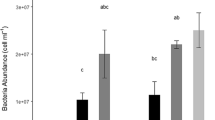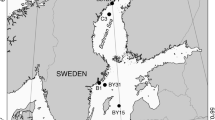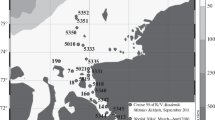Abstract
Three methods of estimating bacterial productivity were compared using parallel samples of Atlantic Ocean water (within 0.25–15 km of the Georgia coast). The frequency-of-dividing cells (FDC) method and the [3H]thymidine incorporation method gave results which were strongly correlated (r=0.97), but the FDC estimates were always higher (X2 to X7) than the [3H]thymidine estimates. Estimates of bacterial productivity ranged from 2–4×108 cells·l−1·h−1 at 0.25 km from shore to 1–9×107cells·l−1·h−1 at 15 km. A method involving incubation of 3-μm filtrates and direct counting gave results that could not be easily translated into estimates of bacterial productivity. Application of the FDC method to sediment samples gave high productivity estimates, which could be not reconciled with productivity estimates based on sediment oxygen uptake.
Similar content being viewed by others
References
Chocair JA, Albright LJ (1981) Heterotophic activities of bacterioplankton and bacteriobenthos. Can J Microbiol 27:259–266
Christian RR, Bancroft K, Wiebe WJ (1978) Resistance of the microbial community within salt marsh soils to selected perturbations. Ecology 59:1200–1210
Cuhel, RL, Taylor CD, Jannasch HW (1982) Assimilatory sulfur metabolism in marine microorganisms: considerations for the application of sulfate incorporation into protein as a measurement of natural population protein synthesis. Appl Environ Microbiol 43:160–168
Ducklow HW (1982) Bacterial biomass and production during spring tidal destratification in the York River, Virgnia, estuary. Limnol Oceanogr 27:in press
Fenchel, T, Blackburn TH (1979) Bacteria and mineral cycling. Academic Press, New York
Fuhrman JA (1981) Influence of method on the apparent size distribution of bacterioplankton cells: epifluorescence microscopy compared to scanning electron microscopy. Mar Ecol Progr Ser 5:103–106
Fuhrman JA, Ammerman JW, Azam F (1980) Bacterioplankton in the coastal euphotic zone: distribution, activity and possible relationships with phytoplankton. Mar Biol 60:201–207
Fuhrman JA, Azam F (1980) Bacterioplankton secondary production estimates for coastal waters of British Columbia, Antarctica, and California. Appl Environ Microbiol 39:1085–1095
Furhman JA, Azam F (1982) Thymidine incorporation as a measure of heterotrophic bacterioplankton production in marine surface waters: evaluation and field results. Mar Biol 66:109–120
Gerlach SA (1978) Food-chain relationships in subtidal silty sand marine sediments and the role of meiofauna in stimulating bacterial productivity. Oecologia (Berl) 33:55–69
Grice GD, Reeve MR (1981) Marine mesocosms. Springer-Verlag, Berlin Heidelberg New York
Hagström A, Larsson U, Hörstedt P, Normark S (1979) Frequency of dividing cells, a new approach to the determination of bacterial growth rates in aquatic environments. Appl Environ Microbiol 37:805–812
Hobbie JE, Daley RJ, Jasper S (1977) Use of Nuclepore filters for counting bacteria by fluorescence microscopy. Appl Environ Microbiol 3:1225–1228
Hollibaugh JT, Carruthers AB, Fuhrman JA, Azam F (1980) Cycling of organic nitrogen in marine planktonic communities studied in enclosed water columns. Mar Biol 59:15–21
Hoppe, H-G (1978) Relations between active bacteria and heterotrophic potential in the sea. Neth J Sea Res 12:78–98
Howard JD, Frey RW (1975) Estuaries of the Georgia coast, U.S.A.: Sedimentology and biology. 1. Introduction. Senkenbergiana Marit 7:1–31
Howard JD, Frey RW, Reineck H-E (1972) Georgia coastal region, Sapelo Island, U.S.A.: Sedimentology and biology. I. Introduction. Senkenbergiana Marit 4:3–14
Howard JD, Reineck H-E (1972) Georgia coastal region, Sapelo Island, U.S.A. IV. Physical and biogenic sedimentary structures of the nearshore shelf. Senkenbergiana Marit 4:61–123
Jordan MJ, Likens GE (1980) Measurement of planktonic bacterial production in an oligotrophic lake. Limnol Oceanogr 25:719–732
Karl DM (1981) Simultaneous rates of ribonucleic acid and deoxyribonucleic acid syntheses for estimating growth and cell division of aquatic microbial communities. Appl Environ Microbiol 42:802–810
Krambeck C, Krambeck H-J, Overbeck J (1981) Microcomputer-assisted biomass determination of plankton bacteria on scanning electron micrographs. Appl Environ Microbiol 42:142–149
Lancelot C (1979) Gross excretion rates of natural marine phytoplankton and heterotrophic uptake of excreted products in the southern North Sea, as determined by short-term kinetics. Mar Ecol Progr Ser 1:179–186
Larsson U, Hagström A (1979) Phytoplankton exudate release as an energy source for the growth of pelagic bacteria. Mar Biol 52:199–206
Meyer-Reil L-A, Bölter M, Dawson R, Liebezeit G, Szwerinski H, Wolter K (1980) Interrelationships between microbiological and chemical parameters of sandy beach sediments, a summer aspect. Appl Environ Microbiol 39:797–802
Meyer-Reil L-A, Dawson R, Liebezeit G, Tiedge H (1978) Fluctuations and interactions of bacterial activity in sandy beach sediments and overlying waters. Mar Biol 48:161–171
Moriarty DJW, Pollard PC (1981) DNA synthesis as a measure of bacterial productivity in seagrass sediments. Mar Ecol Progr Ser 5:151–156
Newell RC, Lucas MI, Linley EAS (1981) Rate of degradation and efficiency of conversion of phytoplankton debris by marine microorganisms. Mar Ecol Progr Ser 6:123–136
Newell SY, Christian RR (1981) Frequency of dividing cells as an estimator of bacterial productivity. Appl Environ Microbiol 42:23–31
Novitsky JA, Kepkay PE (1981) Patterns of microbial heterotrophy through changing environments in a marine sediment. Mar Ecol Progr Ser 4, 1–7
Pamatmat MM, Graf G, Bengtsson W, Novak CS (1981) Heat production, ATP concentration and electron transport activity of marine sediments. Mar Ecol Progr Ser 4:135–143
Parsons TR, Albright LJ, Whitney F, Wong CS, Williams PJ LeB (1981) The effect of glucose on the productivity of seawater: an experimental approach using controlled aquatic ecosystems. Mar Environ Res 4:229–242
Peterson BJ (1980) Aquatic primary productivity and the14C-CO2 method: a history of the productivity problem. Annu Rev Ecol Syst 11:359–385
Pinet PR, Frey RW (1977) Organic carbon in surface sands seaward of Altamaha and Doboy Sounds, Georgia. Geol Soc Amer Bull 88: 1731–1739
Pomeroy LR (1980) Microbial roles in aquatic food webs. In: Colwell RR, Foster J (eds) Aquatic microbial ecology. Univ Maryland Sea Grant, College Park, Md, pp 85–109
Pomeroy LR, Wiegert RG (eds) The ecology of a salt marsh. Springer-Verlag, Berlin Heidelberg New York
Porter KG, Feig YS (1980) The use of DAPI for identifying and counting aquatic microflora. Limnol Oceanogr 25:943–948
Robertson JR, Newell SY (1982) Experimental studies of particle ingestion by the sand fiddler crabUca pugilator (Bosc). J Exp Mar Biol Ecol 59:1–21
Rublee PA, Cammen LM, Hobbie JE (1978) Bacteria in a North Carolina salt marsh: standing crop and importance in the decomposition ofSpartina alterniflora. Univ North Carolina Sea Grant Publ. UNC-SG-78-11, 1–80
Schleyer MH (1981) Microorganisms and detritus in the water column of a subtidal reef of Natal. Mar Ecol Progr Ser 4:307–320
Sieburth JM (1976) Bacterial substrates and productivity in marine ecosystems. Ann Rev. Ecol Syst 7:259–285
Sieburth JM (1979) Sea microbes. Oxford Univ Press, New York
Sokal RR, Rohlf RJ (1969) Biometry. The principles and practice of statistics in biological research. W. H. Freeman and Co., San Francisco
Sorensen J, Jorgensen BB, Revsbech NP (1979) A comparison of oxygen, nitrate, and sulfate respiration in coastal marine sediments. Microb Ecol 5:105–115
Turner RE, Woo SW, Jitts HR (1979) Estuarine influences on a continental shelf plankton community. Science 206:218–220
Weiler CS, Eppley RW (1979) Temporal pattern of division in the dinoflagellate genusCeratium and its application to the determination of growth rate. J Exp Mar Biol Ecol 39:1–24
Williams PJ LeB (1981) Microbial contribution to overall marine plankton metabolism: direct measurements of respiration. Oceanol Acta 4:359–364
Yingst JY, Rhoads DC (1980) The role of bioturbation in the enchancement of bacterial growth rates in marine sediments. In Tenore KR, Coull BC (eds) Marine benthic dynamics. Univ of South Carolina Press, Columbia, pp 407–422
Author information
Authors and Affiliations
Rights and permissions
About this article
Cite this article
Newell, S.Y., Fallon, R.D. Bacterial productivity in the water column and sediments of the Georgia (USA) coastal zone: Estimates via direct counting and parallel measurement of thymidine incorporation. Microb Ecol 8, 33–46 (1982). https://doi.org/10.1007/BF02011459
Issue Date:
DOI: https://doi.org/10.1007/BF02011459




